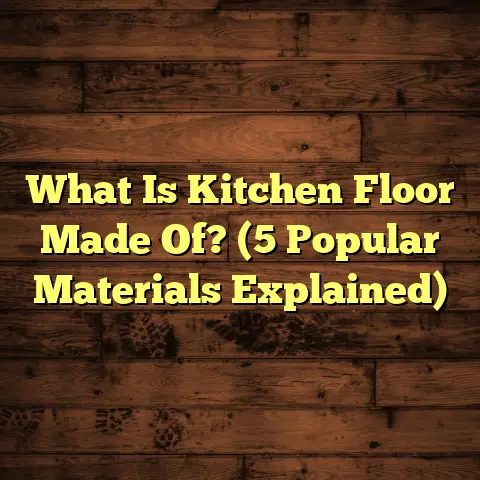What is Floor Sheet? (5 Key Benefits for Your Flooring Needs)
Focusing on the future of your home’s flooring means thinking beyond the look and style. You want something that lasts, feels good underfoot, fits your budget, and is easy to live with day after day. Over the years, I’ve worked with many flooring materials, but one option that I’ve grown to appreciate deeply—and recommend often—is the floor sheet. If you haven’t given it much thought before, that’s okay. Let me walk you through what floor sheets are, why they might be exactly what you need, and share some hands-on tips based on my own projects.
What Is a Floor Sheet?
Let’s start with the basics. What is a floor sheet? In simple terms, a floor sheet is a broad, continuous panel of flooring material that comes in rolls or large sheets instead of individual planks or tiles. Think of it as a giant carpet, but made from materials like vinyl, linoleum, rubber, or composite plastics designed specifically for floors.
Unlike traditional flooring types—where you place pieces one by one—floor sheets cover the entire floor as a smooth, single surface or with minimal seams. This makes them unique and offers a very different experience in terms of installation, durability, and maintenance.
Materials Used for Floor Sheets
The most common materials I’ve worked with and seen used for floor sheets include:
- Vinyl: Highly popular for residential and commercial use. It’s flexible, water-resistant, and can mimic wood or stone.
- Linoleum: Made from natural materials like linseed oil and cork dust. It’s eco-friendly and has great resilience.
- Rubber: Known for its cushioning effect and slip resistance. Great for gyms, playrooms, or wet areas.
- Composite Plastic: These are newer options combining polymers for extra durability.
Each material has its own pros and cons, which I’ll touch on as we go along.
How Floor Sheets Differ from Other Flooring Types
You might ask: How is a floor sheet different from laminate or hardwood? Well, laminate and hardwood come in individual boards or planks that you fit together like puzzle pieces. You’ll see gaps or seams between each piece, which can expand or contract with temperature changes.
Floor sheets are continuous surfaces. That means fewer seams or joints to worry about. This feature alone changes how you maintain and clean the floor. Plus, installation techniques differ since you’re laying down large sheets instead of fitting multiple pieces.
My First Encounter with Floor Sheets
When I first started in flooring, I mostly dealt with hardwood and tile jobs. Then came a shift—I was asked to install vinyl floor sheets at a local community center gym. It was my first time working with this material on a big scale. The job was faster than expected and the end product was impressive: smooth, resilient, and perfect for heavy foot traffic.
That experience opened my eyes to the possibilities of floor sheets—not just for commercial spaces but also for homes looking for practical yet stylish flooring.
5 Key Benefits of Floor Sheets for Your Flooring Needs
Now let’s get into why I often recommend floor sheets to homeowners and business owners alike. These benefits aren’t just theory—they come from years of hands-on work and client feedback.
1. Durability That Lasts
One thing I always emphasize is the durability of your flooring investment. Floor sheets stand out here. Materials like commercial-grade vinyl can last 15-20 years or more if installed properly and cared for right.
Here’s why:
- Resistance to Wear: Vinyl and rubber sheets resist scuffs and scratches better than many hardwoods.
- Waterproof Qualities: Unlike wood or laminate that can warp when wet, vinyl and rubber sheets repel moisture.
- Impact Absorption: Rubber floor sheets absorb impact, making them ideal for gyms or playrooms where falls happen.
I remember working with a hospital that chose vinyl sheets for their corridors. These floors faced thousands of footsteps daily but showed minimal wear even after 10 years. That’s impressive durability.
Data Point:
According to the Resilient Floor Covering Institute (RFCI), vinyl flooring (including sheet vinyl) has an estimated lifespan of 10-20 years in commercial settings under heavy use.
2. Installation Speed and Simplicity
Imagine reducing your flooring installation time by half or more—that’s what I’ve seen when installing floor sheets versus tile or plank options.
Because floor sheets come in large rolls or panels, installation involves rolling out the sheet over a prepared subfloor rather than placing dozens or hundreds of tiles or planks individually.
In one project renovating a daycare center’s playroom, the floor sheet installation took only two days compared to a week-long tile installation estimate. The fewer seams also mean less room for error during fitting.
However, there’s a catch: your subfloor needs to be perfectly smooth and clean to avoid bumps or bubbles after installation. I always advise clients to invest time in subfloor prep because it makes all the difference.
3. Effortless Maintenance
If you hate spending hours cleaning floors (and honestly, who doesn’t?), floor sheets are a revelation.
Because they form one continuous surface with minimal seams:
- Dirt doesn’t get trapped in grout lines like tile.
- Mopping is quicker since you don’t have to scrub edges between planks.
- Water-resistant materials let you clean spills without worrying about damage.
I recall chatting with a restaurant owner who said their vinyl sheet floors survived years of food spills and grease without staining or needing replacement. They just mop daily with mild detergent, and the floor looks fresh.
Rubber sheets add safety too—they’re slip-resistant and durable in wet environments like bathrooms or kitchens.
4. Budget-Friendly Flooring Solution
If budgets matter to you (and who can say no to saving money?), floor sheets offer excellent value.
Let me share some real numbers from recent projects:
| Flooring Type | Average Cost per Sq Ft (Materials + Installation) |
|---|---|
| Hardwood | $8 – $15 |
| Ceramic Tile | $7 – $12 |
| Luxury Vinyl Sheet | $4 – $7 |
| Laminate | $4 – $8 |
You can see that vinyl floor sheets fall on the lower end but still provide durability similar to pricier hardwood or tile options.
Plus, installation time savings translate into lower labor costs too—a double win.
5. Style Flexibility That Surprises
People often assume floor sheets are plain or boring—but that couldn’t be further from reality.
Modern printing technology allows manufacturers to replicate wood grains, stone textures, marble veining, even intricate patterns—all printed on sheet vinyl or linoleum without the high cost or maintenance of real wood or stone.
I’ve had clients amazed by how natural some luxury vinyl sheets look once installed.
One family wanted the look of herringbone hardwood but without the price tag or upkeep. We found a vinyl sheet with that exact pattern—installed it in their kitchen—and it fooled many guests into thinking it was real wood!
Tips From My Experience Installing Floor Sheets
Over the years, I’ve learned some practical lessons that help make your floor sheet project smooth and satisfying:
Tip 1: Always Prep Your Subfloor Thoroughly
A clean, level subfloor is non-negotiable if you want your floor sheet to lay flat without bumps or bubbles.
I’ve seen clients try to cut corners here—only to have wrinkles or air pockets appear weeks later. Fixing those means lifting the entire sheet again—a costly headache.
Tip 2: Pick Quality Materials Over Cheapest Options
It’s tempting to grab the cheapest sheet you find online or at a big box store. But lower-quality materials tend to wear out faster, fade under sunlight, or tear easily.
Investing in reputable brands pays off through longevity and appearance retention.
Tip 3: Thickness Matters
Thicker vinyl or rubber sheets feel more solid underfoot and provide better sound insulation.
For high-traffic areas like hallways or commercial kitchens, I suggest at least 2mm thickness for vinyl sheets. Thicker rubber options are great where cushioning matters most.
Tip 4: Order Extra Material
No matter how precise your measurements are, expect some waste from trimming around edges and mistakes during handling.
Ordering 5-10% more material than your measured square footage avoids last-minute shortages that stall installation.
Tip 5: Consider Professional Installation
While floor sheets can be DIY-friendly if you have patience and skill, professional installers ensure seams are sealed perfectly—especially for waterproof applications like bathrooms—protecting your investment over time.
Personal Story: A Basement Transformation Case Study
A few years ago, I helped a family convert their dark basement into a bright playroom for their kids. They wanted something safe underfoot but easy to clean after spills and art projects.
We decided on colorful rubber floor sheets—not only did they add cushion but also non-slip safety and vibrant patterns that kids loved.
The installation took two days. The parents told me later how much easier cleanup was compared to their old carpeted basement—and how happy they were that the floor remained intact even after years of rough play.
That project showed me how floor sheets can meet very specific family needs while delivering durability and style at a great price point.
Interesting Industry Data About Floor Sheets
- According to HomeAdvisor surveys, 62% of homeowners prefer low-maintenance flooring options—floor sheets fit well here due to seamless design.
- Vinyl flooring sales have been growing steadily by about 5% annually in the U.S., driven by affordability and design variety.
- Flooring Trends Magazine reports that seamless surfaces like floor sheets contribute positively to indoor air quality by reducing dust accumulation points compared to grout-heavy floors.
- A study from the National Floor Safety Institute found rubber floor sheets reduce slip-and-fall accidents by up to 30% compared to hard tile floors in commercial kitchens.
What About Environmental Impact?
You might wonder about sustainability since some flooring materials can be harsh on the environment. Here’s what I’ve learned:
- Linoleum is one of the more eco-friendly floor sheet options since it’s made from natural renewable materials.
- Vinyl production involves plastics derived from petrochemicals but modern manufacturing uses recycling programs reducing waste.
- Rubber sheets made from recycled tires help divert waste from landfills while providing durable surfaces.
If environmental concerns are high on your list, linoleum sheets might be worth exploring despite being less common today than vinyl.
How to Choose the Right Floor Sheet for Your Project
Here are some questions I ask clients when helping select floor sheet materials:
- What type of room will this be? High moisture? Heavy traffic?
- Do you prefer natural materials or synthetic?
- What’s your budget range?
- How important is cushioning underfoot?
- Do you want a specific pattern or texture?
These answers guide me toward recommending vinyl sheets for moisture resistance, rubber for cushioning/safety areas, or linoleum if sustainability is key.
Common Myths About Floor Sheets Debunked
People sometimes hesitate about floor sheets because of misconceptions:
Myth 1: Floor Sheets Look Cheap
Not true anymore! Modern printing tech delivers realistic patterns mimicking wood, stone—even tile mosaics—with none of the grout maintenance hassle.
Myth 2: Floor Sheets Are Hard to Replace if Damaged
Because they come in large pieces, replacing small damaged sections can be tricky but not impossible. With proper care, damage is rare though—and repairs can be done professionally without full replacement.
Myth 3: Floor Sheets Aren’t Comfortable Underfoot
Rubber-based sheets offer excellent cushioning; thicker vinyl also feels far better than thin laminate planks. Comfort depends largely on material choice and thickness.
What About Longevity Compared to Other Floors?
Compared side by side with hardwood or tile:
| Flooring Type | Typical Lifespan (Years) | Maintenance Level |
|---|---|---|
| Hardwood | 20 – 50+ | Moderate; refinishing possible |
| Ceramic Tile | 30 – 50+ | Low; grout upkeep needed |
| Vinyl Floor Sheets | 10 – 20 | Low; occasional cleaning |
| Rubber Floor Sheets | 10 – 25 | Low; simple cleaning |
Vinyl and rubber may not last as long as hardwood but cost less upfront and require minimal upkeep—perfect if you want balance between value and durability.
How I Use FloorTally Tool for Project Estimates
When planning projects with clients considering floor sheets, I rely on tools like FloorTally to get accurate cost estimates quickly. It factors in:
- Local labor rates
- Material types
- Waste factor
- Installation complexity
Using such tools helps me create realistic budgets so clients know what to expect before starting work—avoiding surprises mid-project.
Final Thoughts on Floor Sheets
Floor sheets offer an interesting combination of benefits:
- Long-lasting durability
- Quick installation
- Easy cleaning
- Cost savings
- Style options
Whether you’re remodeling a kitchen, outfitting a gym, or finishing a basement playroom like mine once did—they’re worth serious consideration.
What kind of space do you have? Would you consider trying floor sheets? If any part of this sounds right for your project—or if you want help deciding—I’m here to chat anytime!





